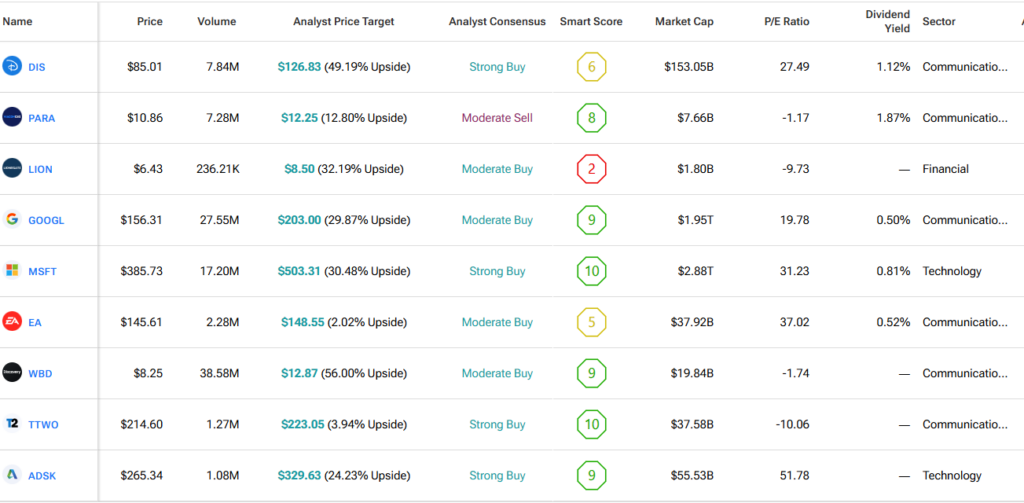Last December, OpenAI released Sora, one of its groundbreaking features, to complement the ChatGPT experience. And after using it for the first time, I was mind-blown. It’s not perfect — it doesn’t really understand cause and effect or general logic, and it mainly maps patterns from the prompt. However, to quote ChatGPT itself: “It lacks semantic understanding… still, it’s wild how far it’s come.”
Indeed, the long-term implications for the entertainment industry are tectonic. We’re talking seismic shifts in film, gaming, and design software sectors — industries dominated by publicly traded giants. But here’s the kicker for investors: these shifts don’t just affect production workflows — they’re already moving stock prices, shaking up cost structures, and redrawing the competitive map. Adobe (ADBE) and Shutterstock (SSTK) dropped significantly after Sora’s debut. Meanwhile, studios and platforms are reallocating capital toward AI tooling at a pace that could catch slower players flat-footed.
If you’re an investor trying to spot the next breakout trend in entertainment, pay attention. AI video isn’t just a novelty — it’s a margin play, a market share play, and potentially, a moat-widening tool for the companies that move fast and smart.
In this piece, we’ll explore briefly how the feature works, its expected timeline, likely reactions, and — more importantly — its disruptive nature. And of course, we’ll look at the publicly traded studios and platforms most likely to be affected, for better or worse.
My Experience with Sora
Here’s what I prompted Sora to do: generate a film noir scene in chiaroscuro. Picture a shadowy office, a detective behind a desk, and a brunette secretary in a 1940s dress handing over a confidential file. Classic Bogart vibes.
Sora gave me… five seconds. The visuals were on point—moody lighting, black and white aesthetic—but not quite what I requested. The camera didn’t move, the secretary didn’t enter the room, and she didn’t hand over the file—she dropped it. Still, for five seconds of AI-generated footage? It felt like a glimpse into the future.
To conclude my test drive with Sora, there’s still work to be done, but the overall outcome was overwhelming. This is nothing short of a game-changer.
Sora: How It Works and Where It’s Going
Sora turns text prompts into video by treating visuals like a sequence of video patches. It uses a type of transformer architecture – the same family of tech that powers ChatGPT – but now it learns patterns in images and motion, not just words. It’s like giving a robot director a script and letting it build a few seconds of a movie.
Right now, it can only create clips that are up to 20 seconds long. However, competitors like Google’s Veo (GOOGL) have already crossed the one-minute mark behind closed doors. The key bottlenecks? Keeping scenes coherent, remembering details, and making actions follow logically. Still, we’re moving quickly toward longer and more story-driven outputs. By 2026, expect high-quality minute-long clips. By the end of the decade, we may well see an entire AI-generated film.
Lights, Camera, No Budget?
Sora’s biggest disruption is that it can make visuals that used to cost tens of thousands of dollars, or weeks of work from a visual effects (VFX) team, almost instantly and for a fraction of the cost. Imagine storyboarding a sci-fi movie or creating an animated fantasy sequence with just a laptop and some prompts.
For studios, this could slash budgets. For example, AI-generated sets and crowd scenes might replace expensive on-location shoots and extras. VFX fixes, like removing cables or filling in backgrounds, could be done faster with AI. Deloitte predicts that even a 3% shift in studio budgets to AI content tools could lead to massive efficiency gains. James Cameron, the ‘Terminator’ director, recently said AI could “boost VFX speed” and help directors do more for less.
The Indie Uprising
The other big story here is creative independence. Filmmakers and game designers who once needed big studios to realize their vision can now prototype ideas at home. YouTubers are already using AI tools to create short animated series and trailers. Platforms like TikTok and YouTube may become hotbeds of AI-first content. Like iPhones and Instagram, which have turned everyone into photographers, Sora could turn anyone into a filmmaker.
It’s easy to imagine a near-future where indie creators release animated shows, films, or games with visuals rivaling Pixar or PlayStation without hiring a team. When this happens, competition for attention will only get fiercer.
How the Big Studios Might Adapt
Publicly traded entertainment giants are watching closely, no doubt.
Netflix (NFLX) might be the fastest mover. It’s already used AI in background animation for anime and could use tools like Sora to test out visual ideas or generate international versions of a show. Disney (DIS), which holds vast creative IP from Marvel, Pixar, and Star Wars, could train its custom AI models on its archive, creating a “Disney style” generator to accelerate production.
Meanwhile, Lionsgate Studios (LION) has already struck a deal with Runway, one of Sora’s rivals, to use generative video tools in production. It’s the first major studio to openly team up with a generative video startup, and a sign of what’s to come. Paramount (PARA) and Warner Bros. (WBD) are likely experimenting quietly too, hoping to cut costs without alienating creatives.
Game on: The Impact on Gaming
Game publishers like Electronic Arts (EA), Take-Two (TTWO), and Activision, now part of Microsoft (MSFT), also stand to benefit. Sora-like tools can generate cinematics, environments, or animated loops that once required large art teams. This can reduce costs and development timelines. Unity, the engine thousands of game developers use, is already integrating AI co-pilot tools. Autodesk (ADSK), behind Maya and 3ds Max, has realigned its workforce to double down on AI.
Smaller game studios may gain the most. The playing field between indie and AAA titles becomes more level if they can generate game trailers, background stories, and characters using AI. More games, faster, and cheaper.
So What Now?
We’re still early in this revolution. Sora isn’t ready to direct the next Marvel movie or replace artists, but it’s certainly good enough to augment them. And as the tech evolves, the line between AI-assisted and human-led production will blur. What matters is how creators and companies choose to use it.
If used wisely, Sora could become the next great tool in the creative toolbox. If ignored, it could become the tool others use to outpace you. One thing is clear: in the entertainment world, the script is being rewritten while you’re reading this text.
Tipranks’ Comparison Chart enables investors to gain a broader perspective on each stock mentioned in the article. In this case, stocks from the entertainment industry.

















